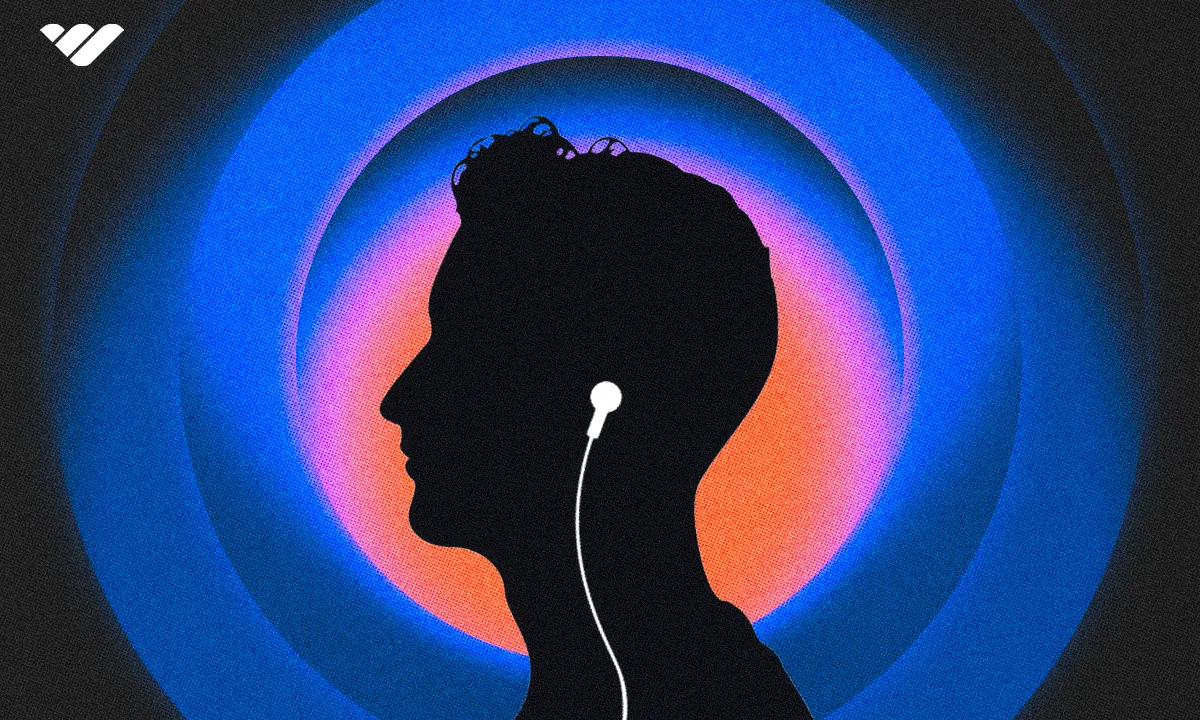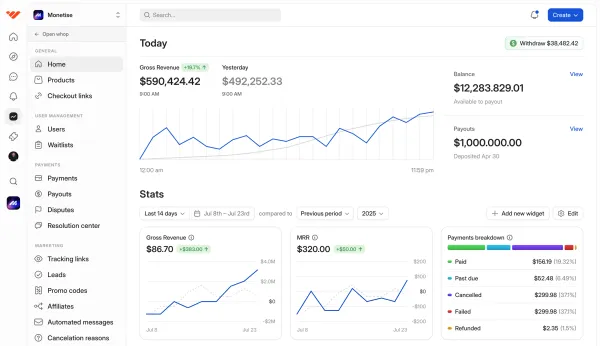Start a podcast the easy way - grab basic gear, pick a niche, and use a host that helps you grow, monetize, and build your brand fast.
Key takeaways
- Podcasting is now a $32.48 billion industry with creators making real money.
- Define your podcast's specific niche instead of trying to appeal to everyone.
- Weekly episode releases work well for most podcast formats and audiences.
- You can start podcasting with just your smartphone using apps like Anchor.
- Video podcasts on platforms like YouTube increase reach and engagement significantly.
The easiest way to start a podcast? Grab some basic gear, pick a topic you actually care about, and use a host that records, publishes, and distributes everywhere.
Podcasting isn’t just a side hustle anymore - it’s a booming $32.48 billion industry, and creators everywhere are cashing in.
With a simple setup and a solid format, you can grow an audience, build a brand, and start making real money.
Starting your first podcast: A step-by-step guide
You’ve seen creators turn shows into full-blown brands and serious income. Here’s the simple path to get yours off the ground - fast.
Step 1. Figure out your podcast’s niche
Your podcast niche defines your content strategy, your target audience, and how you stand out.
Getting this right early helps listeners quickly understand what your show is about (and why they should keep coming back).
Here’s how:
Define your show’s purpose:
First question: Why do you want to start a podcast?
Maybe it’s building your brand, sharing your passion, or growing your business with authentic marketing.
Whichever it is, knowing your purpose will keep you focused and consistent with the end goal.
"The first thing you really want to understand is what your business model is going to be.
Are you going to try to get as many views as possible so you can get sponsors? Or are you trying to drive traffic to a digital product?"
— Brett Malinowski, founder of WGMI podcast and Head of Marketing at Whop
Choose a topic and a focus you love:
You're going to spend a lot of time creating episodes, so pick something that genuinely interests you and won’t become boring by episode 3.
"I'd make sure to emphasize podcasting about your passion in some way, shape, or form.
I don't care if it's comedy, politics, horror, or sewing, if you don't care about what you are talking about, no one else will. And passionate resonates."
— Jon Grilz, fiction podcaster from Bloody Disgusting Podcast network
Your enthusiasm will shine through your content, resonating with listeners and helping you stay motivated.
Get clear on your target audience:
Be clear on who you’re trying to reach.
Instead of trying to appeal to everyone, focus on a particular group with shared interests or challenges.
This makes it easier to create content that resonates.
"Don’t start by asking how to build an audience for your podcast. Instead, ask how to build a podcast for your audience."
— Justin Jackson, founder of Transistor.fm
Narrow your focus:

The most successful podcasts focus on a specific angle or niche.
For example, instead of a general fitness podcast, try one that provides fitness tips for college students, or health and wellness for busy creatives.
You should try to create content that stands out from the rest and isn't readily available on competing podcasts. So you should do research, and find your edge.
"A podcast's product is its unique line of questioning. You need to ask a set of questions that the guest has not been asked anywhere else."
— Brett Malinowski, founder of WGMI podcast and Head of Marketing at Whop
Test ideas before committing:
Come up with 5 to 10 potential episode topics, and try to create rough episode outlines.
Finding it hard to come up with enough ideas? You probably need to adjust your niche to ensure you can keep producing fresh content.
Pick a memorable name:
Your podcast name is going to be the first thing people notice.
So, you should choose a name the reflects the edge of your niche. Also, double-check that the name isn’t already in use on major platforms and social media.
A great example? The true-crime podcast Criminal – it’s pretty clear what they cover.
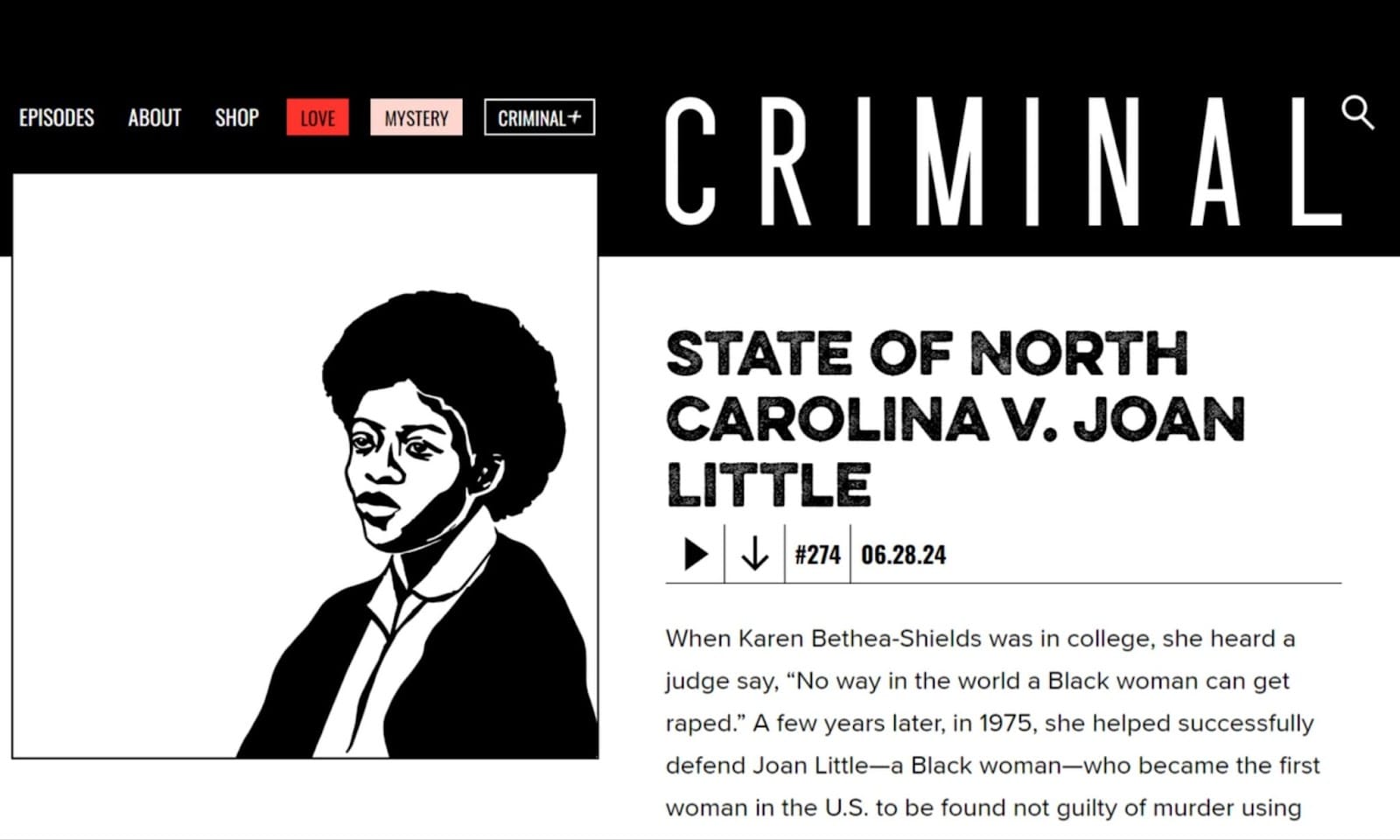
Step 2. Choose the right format
Your podcast niche will often help determine the best format for your show.
Different topics work better with certain styles, so picking the right format helps keep your content engaging and fits your audience’s expectations.
The head of marketing at Whop, Brett runs his own podcast where he interviews young entrepreneur guests. An interview format works for this long-form, insightful video content.
Here are the main podcast formats and who they work best for:
- Editorials: Think: The Ben Shapiro Show or The Broski Report. Direct to cam, news-reader style format. Great for opinionated takes or deep dives where you lead the conversation solo.
- Discussions: Think: Lights, Camera, Barstool. Ideal when you want multiple hosts or guests to bounce ideas around. Works well for culture, sports, or general chat.
- Call-ins: Awesome for audience interaction, letting listeners join the conversation live or send questions. Fits advice or Q&A shows, can also just be a section of each episode.
- Reviews: Perfect if you want to break down new products, movies, books, or games. Good for entertainment or tech niches.
- Interviews: Bring expert voices or inspiring stories into your podcast. Common in business, health, or creative niches.
- Creative storytelling: Ideal for fiction or true stories, where you craft a narrative to captivate listeners. Perfect for lifestyle, history, or personal stories.
Episode length can also vary (a lot): solo editorial podcasts might be short and punchy (around 15 minutes), while discussion or call-in shows can go long – some even run for several hours.
The Joe Rogan Experience often drops episodes lasting two to four hours, which is perfect for the deep dives he gets into with guests.
Choosing the best format for your niche helps your podcast feel natural and keeps listeners coming back for more.
Pro tip: Listen to some sample episodes in your niche to get an idea of what works and what you could do better.
Step 3. Pre-plan your podcast schedule
Like all content, podcasts tend to lose momentum without structure. Having a clear episode plan from the start makes things a lot smoother.
Map out your first 8-10 episodes and test whether your idea has long-term potential (and if you’ll actually enjoy talking about it).
If you run out of ideas after episode three, you might have a few solid blog posts, not enough for a full podcast series.
On the flip side, if your ideas are too broad or scattered? It could be a sign to narrow your niche.
How often should you release episodes?
Weekly is a great starting point. It’s frequent enough to stay on your audience’s radar without overwhelming you. That said, frequency depends on your niche and format:
- Editorials, call-ins, interviews: Weekly works well to allow enough time to gather fresh material/news/guests.
- Creative, reviews, discussions: Anywhere from 1-3 times per week, depending on episode length.
Whatever schedule you choose, try to stick to it. Consistency builds trust and keeps listeners coming back.
However, if you find you’re struggling to retain viewers or build enough hype per episode in the beginning, pivot your schedule and see if things improve.
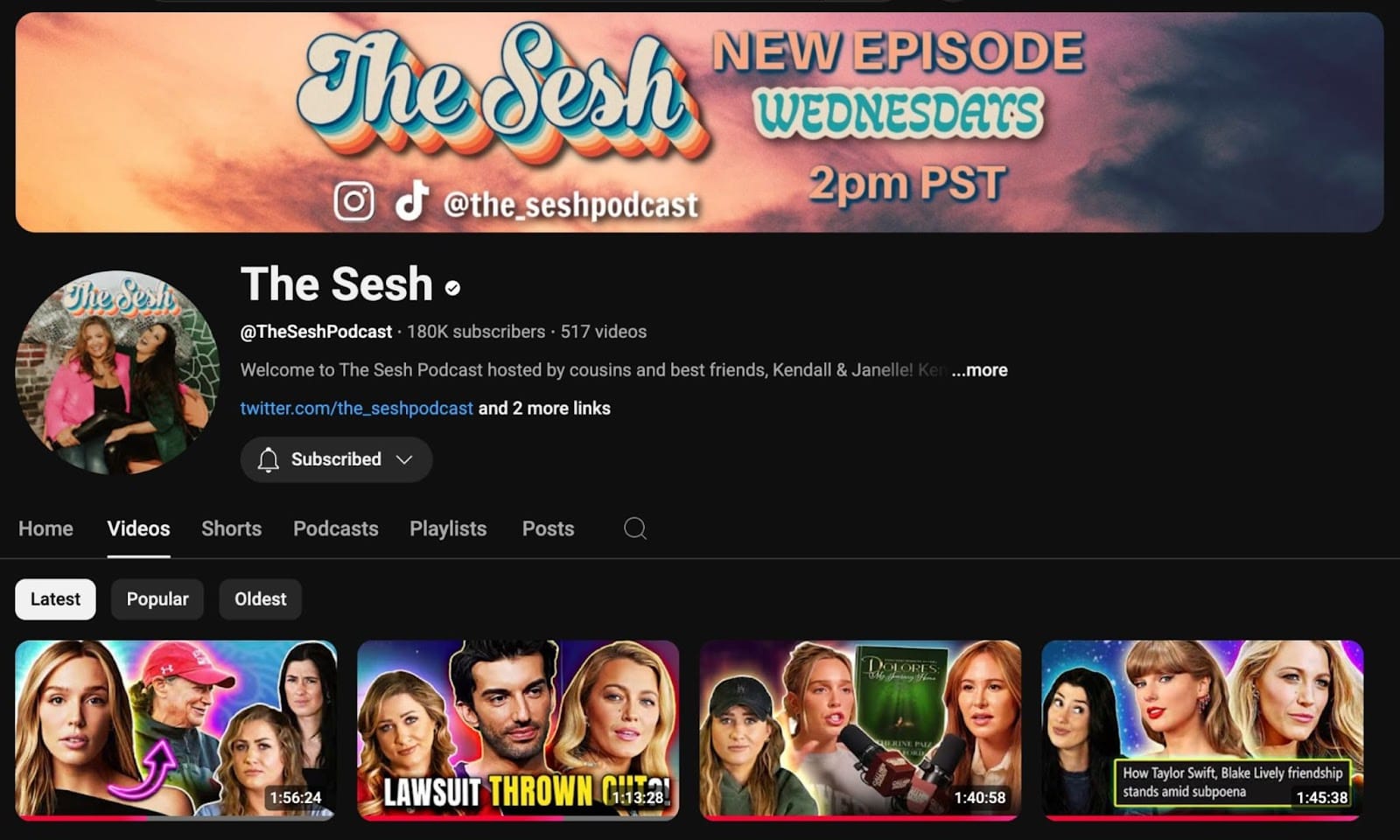
The Sesh is a weekly podcast between two best friends with sections involving mental health, celebrity news, and pop culture events.
Pro tip: Poll your audience via socials and see what they prefer, or ask them to leave a comment under each episode! This is the best way to find out what your listeners want and have the time to engage with.
Step 4. Build your setup (without breaking the bank)
You don’t need a fancy studio or expensive gear to start podcasting. In fact, you can launch your show with what you already have, and upgrade as you grow.
Option 1: Start with your phone
Your smartphone is more powerful than you think.
Apps like Anchor by Spotify and Audacity (desktop) let you record, edit, and publish episodes all in one place.
This is the easiest way to test your podcast idea before investing in any gear.
Option 2: Get some beginner equipment
When you're ready for better sound and more flexibility, a simple home studio can give you that professional edge. Here’s what you’ll need:
- Microphone
- Headphones
- Computer
- (Optional) Digital recorder for mobile or offline recording
"I record by myself in my studio, a converted back-house. The room I record in is maybe 10x14 with a bunch of DIY acoustic treatment."
— Lindsay Graham, host of podcasts 'American History Tellers', 'American Scandal', and 'The Mysterious Mr. Epstein'
Choosing the best podcast microphone:
Your mic has the biggest impact on your sound quality. Here’s a breakdown of the main types:
| Type | Best for | Examples | Price Range | Pros | Cons |
|---|---|---|---|---|---|
| USB Microphones | Beginners, solo podcasters | Blue Yeti, Samson Q2U, Rode NT-USB | $100-$200 | Plug-and-play, no extra gear needed, affordable | Less flexible for multi-mic setups |
| XLR Microphones | Advanced podcasters, professional setups | Shure SM7B, Rode PodMic, Audio-Technica AT2020 | $400-$500+ | Higher sound quality, works with mixers/interfaces | Requires audio interface, more expensive |
| Lavalier (Lapel) Microphones | On-the-go recording, interviews, video content | Rode SmartLav+, Sennheiser ClipMic | $50-$100 | Hands-free, discreet, good for filming | Picks up background noise, lower audio quality |
| Shotgun Microphones | Video-first podcasts, noisy environments | Rode VideoMic Pro, Deity D3 Pro | $150-$250 | Directional audio, reduces background noise | Placement matters, less warm voice |
Choosing the right podcast camera:
Adding video to your podcast helps boost your reach because you can repurpose episodes across platforms like YouTube, Instagram, and TikTok, and get better engagement.
Plus, in 2024 alone, Spotify saw an 88% surge in users consuming video podcasts.
Here are your main camera options:
| Type | Best for | Examples | Price Range | Pros | Cons |
|---|---|---|---|---|---|
| Smartphone Cameras | Beginners, budget-conscious creators | Latest iPhone, Samsung Galaxy, Google Pixel | $700-$1,500 | Always with you, easy to use, good quality on newer models | Limited zoom and framing control, usually needs external mic |
| Webcams | Live streaming, desktop-recorded podcasts | Logitech C920, Razer Kiyo | $70-$200 | Easy to set up, good for direct-to-computer recording | Lower image quality than dedicated cameras |
| Mirrorless & DSLR Cameras | High production quality, professional podcasts | Sony A6400, Canon EOS M50 | $700-$1,500+ | Excellent image quality, interchangeable lenses, cinematic look | More expensive, needs accessories like tripods and capture cards |
| Action Cameras | Outdoor or dynamic recording | GoPro HERO11, DJI Osmo Action | $350-$500 | Rugged, compact, great stabilization | Not ideal for static/studio shots |
Video podcasts are king, especially on YouTube. You can also livestream episodes on Whop to engage your community in real time, then repurpose the recording for social clips or full episode uploads.
Step 5. Set up your podcast recording space
Once you’ve got your core gear sorted, the environment you record in matters just as much.
Here’s how to create a podcast-friendly studio:
Find a quiet space
Nothing is more off-putting for a podcast than background noise or washed-out audio. Choose a room with minimal outside noise and echo. Try to avoid rooms with lots of hard surfaces like tile or glass, which can cause harsh reflections.
Treat the room acoustically
Soundproofing can get expensive, but even small steps help.
- Use thick curtains, rugs, and soft furnishings to absorb sound
- Hang acoustic panels or foam tiles on walls to reduce echo
- Place bookshelves or couches strategically to break up sound waves
Desk and mic placement
Position your microphone close enough to capture your voice clearly (usually 6-12 inches away), but avoid breathing noises and plosives (please).
Use a boom arm or mic stand for flexible positioning.
Lighting and camera setup
If you’re recording video, invest in soft, diffused lighting to avoid harsh shadows and keep yourself looking clear on camera.
Natural light works well, but avoid direct sunlight on your face.
Minimize distractions
Keep your recording area clutter-free and limit background noise. Turn off fans, computers, or appliances that hum or buzz.
Pro tip: If you don’t have a spare room to record, you can set up a cool studio space in your bedroom, office, or living room.
Just make sure you have time to record with no distractions, especially if living with others. Down the line, you can invest in hiring a recording space.
Step 6. Pick the right podcast host (so you actually get heard)
Want your podcast on Spotify, Apple Podcasts, and all the good stuff? You gotta upload your episodes somewhere. That’s where a podcast host comes in.
Think of it like the middleman between you and your listeners.
Record your episodes, upload them to your host, and they handle sending it out to all the platforms. Easy.
But heads up: not all hosts are created equal. Some have cool extras, some have higher costs, and some are free to start.
Here are the go-to hosts if you’re just starting out:
Buzzsprout
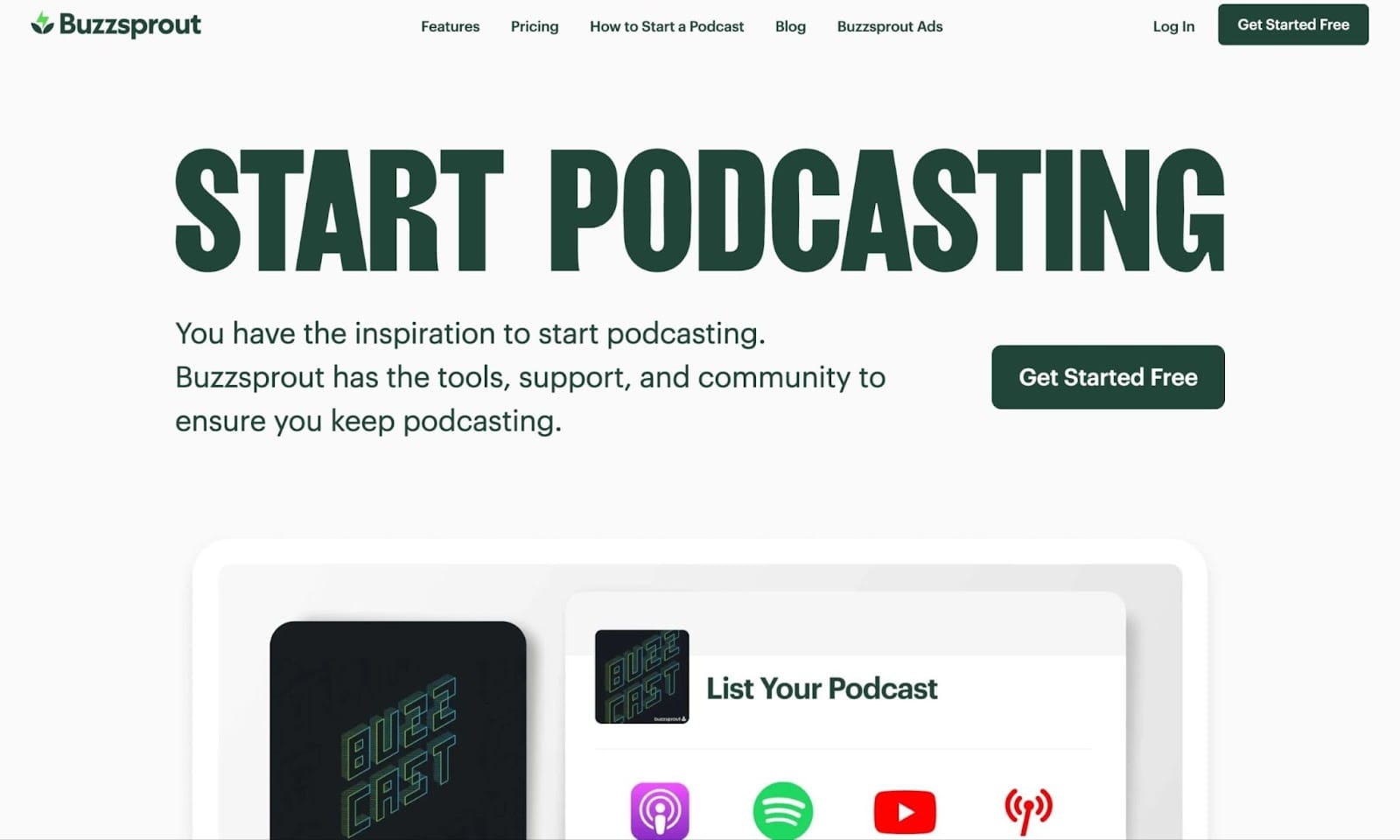
Buzzsprout is a super user-friendly platform perfect for newbies who want solid tools without the stress. It offers automatic transcripts, easy-to-use editing features, and clear analytics to track your growth. Plus, you get a 90-day free trial to test it out. Yay, free sh*t!
Pros: Super newbie-friendly, automatic transcripts, easy audio editing, detailed stats, 90-day free trial
Cons: Free trial ends, then it’s paid plans only
Best for: Beginners who want solid tools and a stress-free start
Spotify for Podcasters
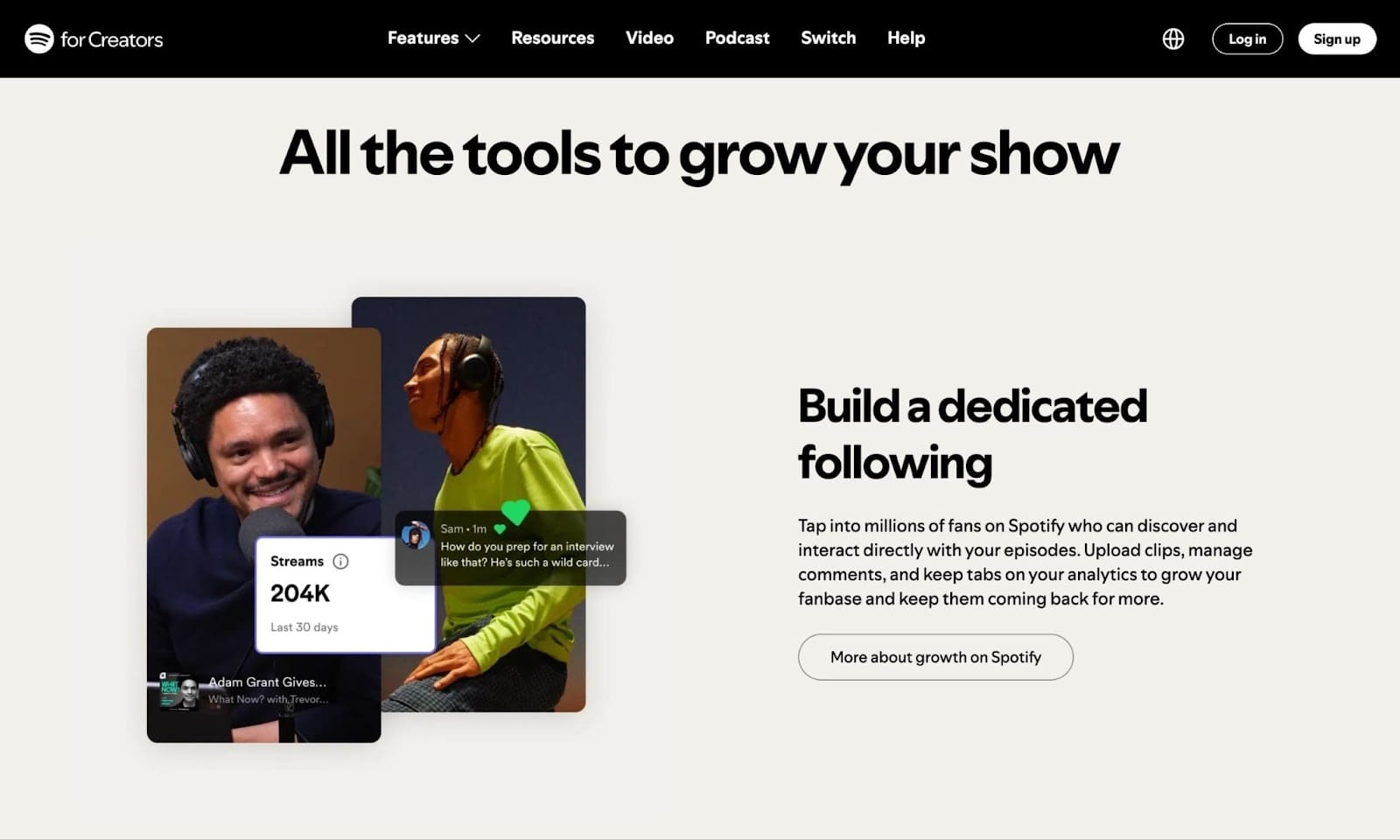
Spotify's own platform is an easy way to get your show on the biggest streaming service for free. It’s simple and fast, but it’s mostly just for uploading to Spotify itself, so it’s limited in features compared to paid hosts.
Pros: Totally free, quick upload to Spotify, simple to use
Cons: Limited features compared to paid hosts, Spotify-only distribution unless you get your podcast's RSS feed and submit it into other platforms
Best for: Beginners testing the waters
Podbean
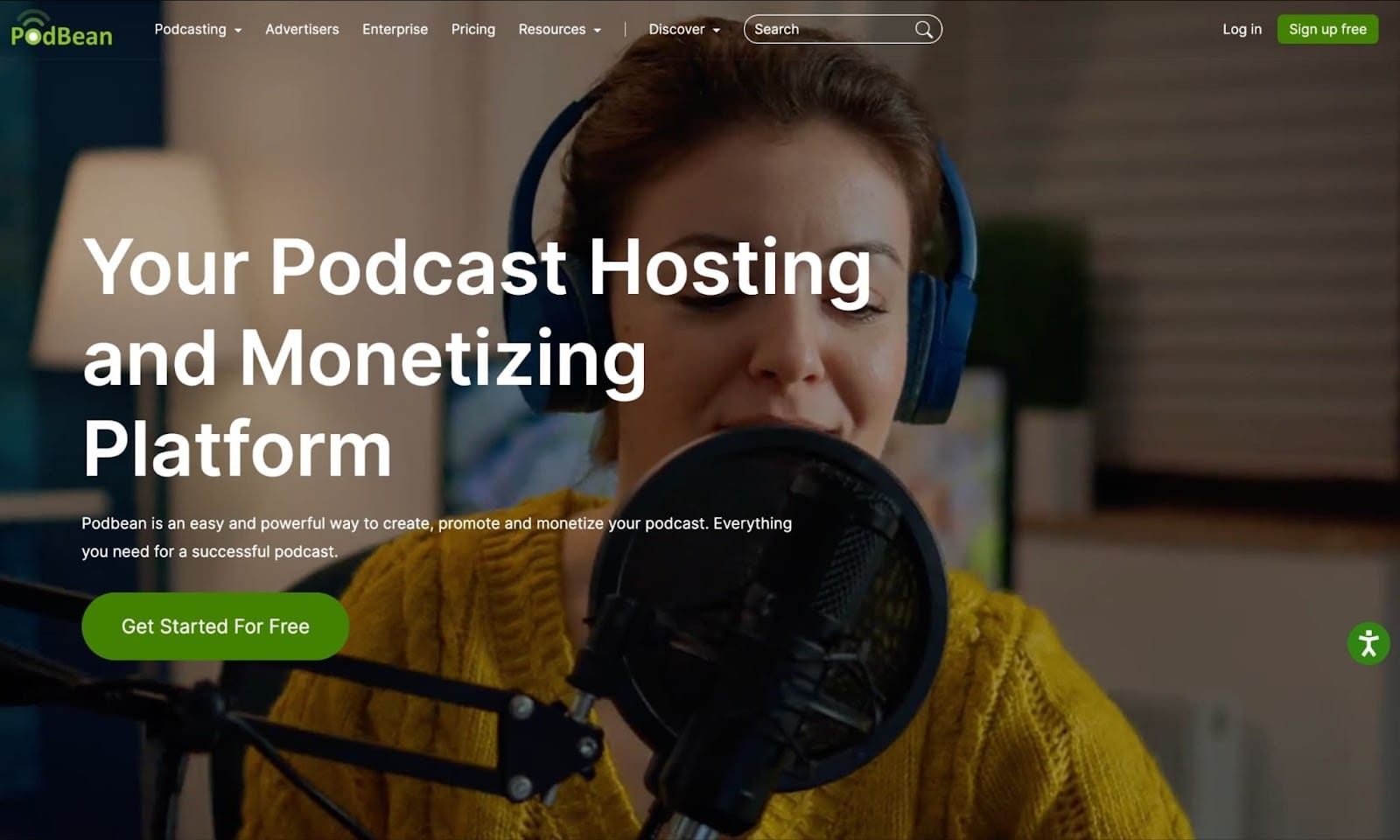
Podbean is known for its straightforward interface and built-in tools that help you monetize and share your podcast. You can start on a free plan and upgrade as your show grows and you want more features.
Pros: Easy interface, built-in monetization and sharing tools, free start with upgrade options
Cons: Free plan limits storage and analytics
Best for: Creators ready to grow and make money eventually
Libsyn
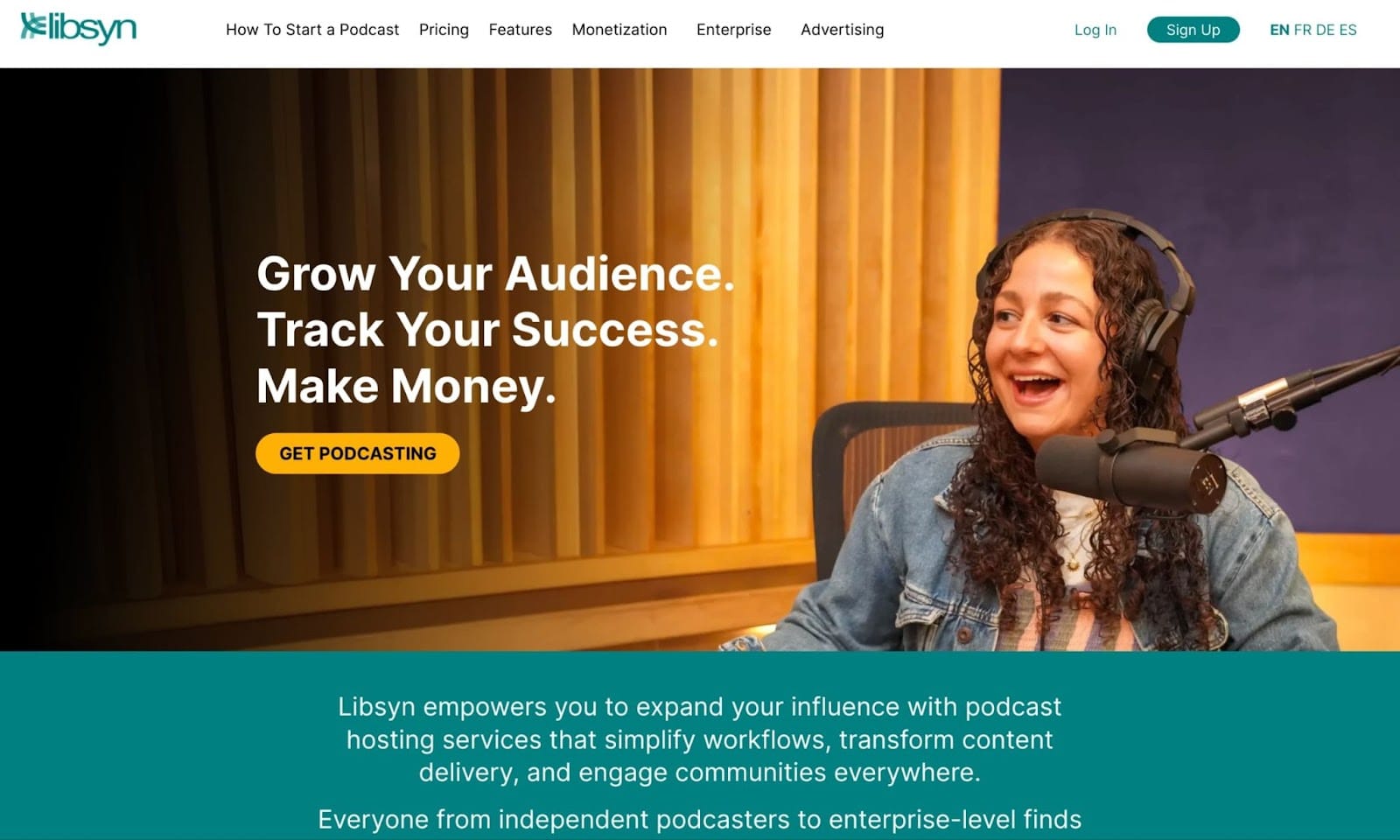
Libsyn is one of the oldest, most reliable podcast hosts out there. It’s packed with features like monetization, distribution, and analytics. No free trial, but plans start at just $7/month, making it great for serious podcasters.
Pros: Reliable, tons of features (monetization, analytics, distribution), affordable plans
Cons: No free trial, interface looks a bit old-school
Best for: Podcasters serious about scaling up and professional growth
Spreaker by iHeart
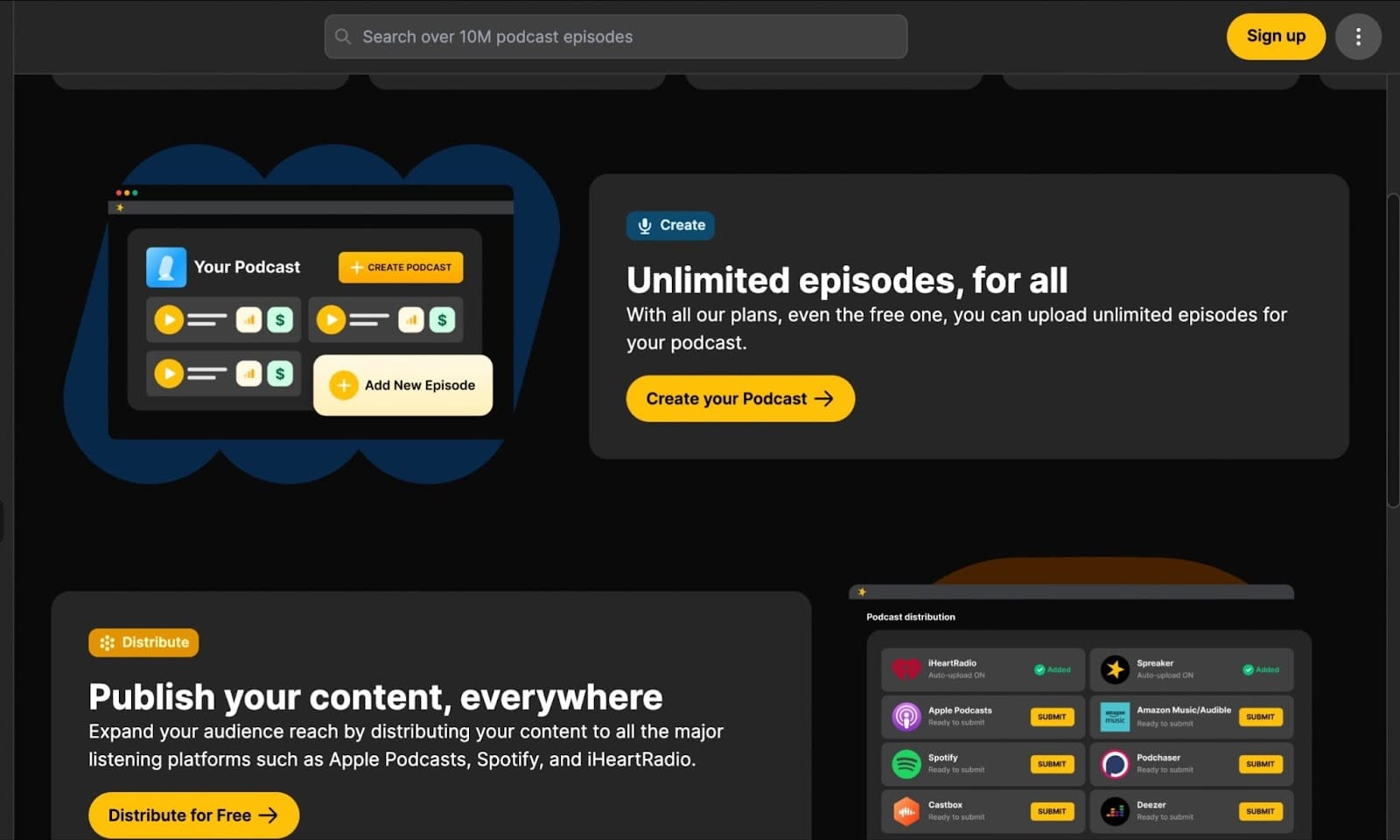
Spreaker is an all-in-one platform letting you record, host, distribute, and monetize your podcast all from one place. It’s got a free basic plan to get started and scales up as you grow.
Pros: All-in-one platform (record, host, monetize), free basic plan available
Cons: Some advanced features require paid plans
Best for: Creators who want everything in one place
Pro tip: Look carefully at each platform’s pricing, features, and reviews. Make the selection based on what works best for you, not what’s most popular or has the nicer branding.
If your end-goal is to make money then check out this list of the top podcast monetization platforms.
Step 7. Prepare your podcast episodes

Recording episodes:
Having episodes ready to go might sound obvious, but the key is to have them fully recorded, edited, and queued up before launch.
Life happens (getting sick, tech glitches, power outages), so having a content bank keeps your show on track with your release schedule.
Let’s talk pilots: your first episode sets the vibe and introduces you to your audience, so take the time to get it right. The great thing about recording podcasts? You can do as many takes as you want until it feels perfect.
Aim to make episodes your listeners actually want to download, binge, and share. All podcast types benefit from strong hooks, proper editing, timestamps, clip moments (moments that can go viral), and strong CTAs.
- Presentation-style podcasts (think reviews, news) usually benefit from a script to keep things tight and on point.
- Chat-based or call-in podcasts should feel natural and conversational, just don’t let the convo go flat.
- Interview podcasts shine when you do your homework on guests and have a list of questions ready to keep the flow smooth.
When it’s time to record, pick a quiet, distraction-free space.
Editing episodes:
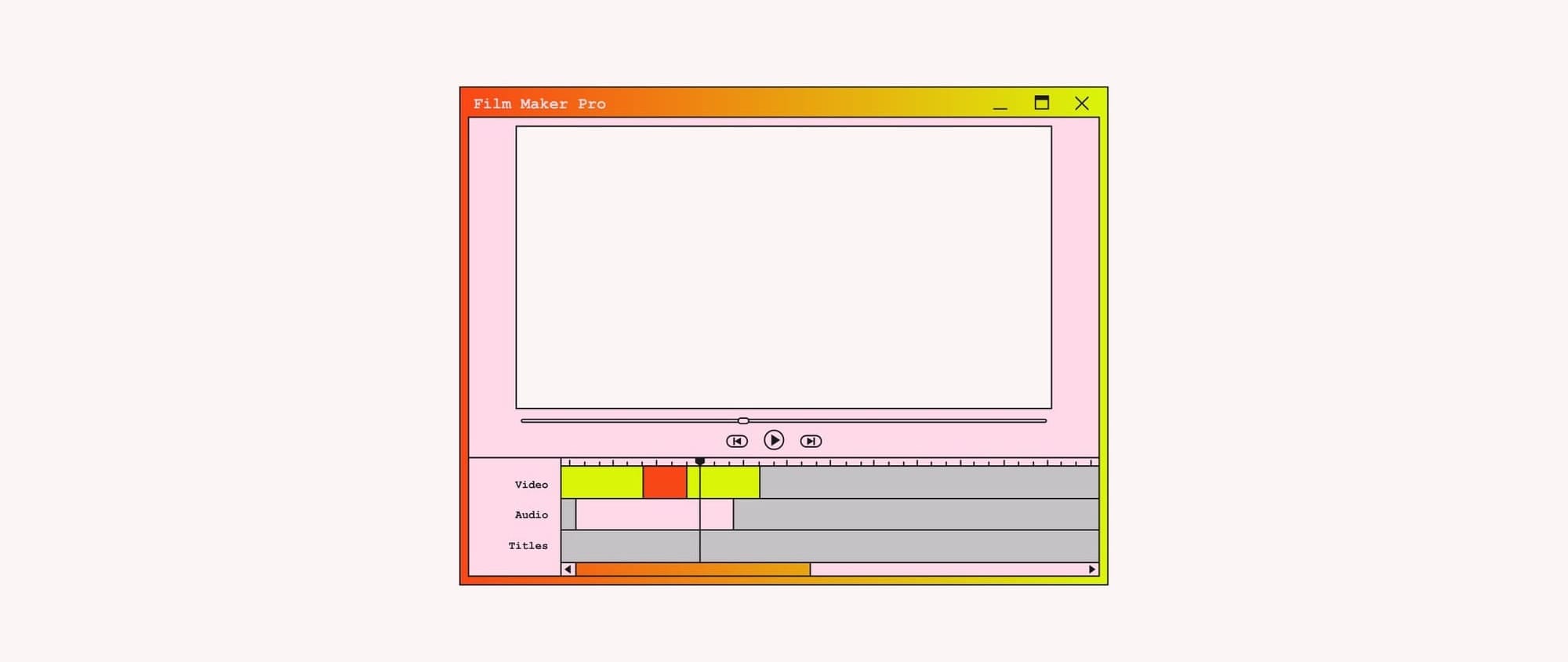
Editing is a must for everyone, whether you’re using professional gear or your iPhone mic. Use editing to balance audio levels, cut out background noise, and polish the final product.
AI tools like Descript, Otter.ai, and Fireflies.ai can streamline your workflow.
They can automatically transcribe your episodes, help with editing, and even remove filler words or ums/ahs. Super handy for beginners.
Once your episode sounds crisp, upload it to your hosting platform and submit it to podcast directories. These directories are like huge libraries where listeners discover and stream shows.
Top directories you’ve probably heard of include Apple Podcasts, Spotify, and Podcast Index.
Pro tip: Keep things organised by using a spreadsheet or Notion template to keep a physical, editable schedule for your podcast, as well as house any notes and interview questions.
Step 8. Get your podcast heard with the right marketing
"People interested in sales coaching are probably in the sales world, so you want to have a guest that knows a lot about sales to attract those people.
That way, I can have very valuable conversations, post out on social media for free, and then people would get recommended this video."
-Brett Malinowski, Head of Marketing at Whop
Uploading your podcast to hosting platforms and directories isn’t the final step, by the way. Actually growing your podcast audience, especially in the beginning, takes consistent effort.
Podcasts are booming, and while that means there’s no better time to jump in, there’s also never been more competition. Carving out your own listener base requires strategy.
The average podcast only gets roughly 141 downloads in its first month. To reach the top charts, you’ll need thousands (like, 3,400+) downloads.
So, how do you stand out? Try these marketing methods:
- Use SEO-friendly keywords: Research keywords that match your podcast’s theme and include them in episode titles, descriptions, and transcripts to boost discoverability.
- Create a show website: Build a dedicated site for your podcast with transcripts, embeds, or condensed blog posts to help search engines find you.
- Repurpose your content: Turn your podcast into YouTube videos, X threads, email newsletters, social media infographics, or personal LinkedIn posts. More formats mean more chances to get noticed.
Check out how health podcaster Dr. Andrew Huberman repurposes podcast content on Instagram:

- Leverage social media: Share episodes on all your platforms, engage with your audience, and keep it authentic.
- Use Content Rewards: Using the Content Rewards app on Whop (an app that allows you to create clipping campaigns), you can pay clippers between $0.20 and $3.00 per 1,000 views to redistribute your clips across socials. You only pay for actual views, and these guys are experienced in getting them – fast.
"The hands-down best thing I think you can do is to first connect with and establish great relationships with other creators in the space.
This will open the door to free promo like ad swaps, crossover episodes, interviews, other types of collabs that will drive audience to your shows."
— Marketer from Realm Media, podcast and entertainment studio (via a Reddit AMA)
Step 9. Start monetizing your podcast $$$

Once you’re up and running, growing, and getting noticed? You’re ready to explore monetization opportunities.
We have a full guide to monetizing your podcast, but for the TLDR, flick below:
- Advertising: Sell targeted ad spots through podcast ad networks.
- Sponsorships: Get paid by brands to promote their products on your show.
- Merchandise: Offer branded gear like shirts, hats, or stickers to your listeners.
- Paid content: Create premium episodes or newsletters behind a paywall or subscription on platforms like Whop.
- Related products: Use a digital marketplace like Whop to funnel listeners and sell ebooks, courses, coaching, or services linked to your podcast topic.
- Affiliate marketing: Promote products and earn commission on sales made through your links.
Make more money from your podcast with Whop
Podcasting isn’t just about dropping episodes and hoping for the best.
It’s about building a real community and giving your fans next-level content and experiences.
That's where Whop shines - Whop is an all-in-one platform where you can host your podcast, build a community around it, drop exclusive content, or even make the community itself paid. Top podcasters are using Whop to level up their brand and access more monetization opportunities.
Coaching, courses, ebooks, newsletters – you name it. With Whop, you can turn your podcast into a full-scale business. Our platform makes managing subs, running communities, and tracking your growth super simple.
Best part? You don't need coding skills or technical knowledge.
Grow your podcast monetization methods with Whop today.
FAQ
What even is podcasting?
A podcast is basically on-demand audio (often with accompanying video) content you can listen to anytime, anywhere.
Creators record episodes and publish them on platforms like Spotify, Apple Podcasts, YouTube Podcasts, and more. Most podcasts are free, but some podcasts are behind paywalls (or are subscription-only), allowing creators to charge premiums for extra perks.
So, what kind of content works? Honestly, anything and everything.
Podcasts usually dive deep into a specific topic or niche, like true crime, gaming, law, self-development, or ecommerce, which is huge.
But they get way more niche than that, too – think esoteric ideology, decentralized health, and off-grid living.
Why should I start a podcast?
Look, I probably don’t need to convince you. But besides the obvious earning potential, podcasting has some other serious perks, too:
- Building a brand
Podcasts aren’t just side gigs — they’re powerful tools to show the world who you are. Along with socials, blogs, and ebooks, a podcast helps you stand out and grow your personal or business brand. - Promoting your business
Got a business? A podcast is one of the best ways to spread the word and keep your products or services front and center. The internet is cluttered with ineffective marketing, but podcasting is engaging and helps brands stay top of mind. - Establishing authority
Podcasts help you build authority in your niche. Whether you’re dropping the latest tech reviews, marketing hacks, or celeb tea, you become the go-to voice people trust and follow. - Sharing stuff you love
Many successful podcasts start from a simple love or hobby – gaming, beauty, true crime, you name it. If you’re excited about something, podcasting could be the perfect way to share it and maybe even turn it into a biz.
How long will it take for me to make money from podcasting?
Podcasting won't start printing money right away. It takes time to build your crew, drop consistent episodes, and actually get people tuning in. Most podcasters start seeing some money after a few months, but it can take a year or more to really cash in.
The key? Stay consistent, keep leveling up your content, and hustle on promos. The grind’s real, but the payoff’s worth it.


